Written in 2016 and updated for 2023, my epic 10 days in Oman itinerary shows you how to plan the perfect Oman road trip.
It covers where to go in Oman, the best things to do in Oman, distances and drive times, accommodation with parking, plus handy driving tips and an interactive map.
Nothing beats a good road trip, and Oman has to be one of the best countries in the Middle East (and the world, for that matter) for independent driving.
The roads are well-maintained, fuel is affordable, and there’s certainly no shortage of things to see and do along the way.
Essential reading: 12 tips that will save you money in Oman.
I’ve been singing the country’s praises ever since we did our own Oman roadtrip. When researching, I came up with the perfect Oman travel itinerary for seeing Oman in 10 days.
Since I’ve been on an Oman binge lately, working on some content for my freelance work, I thought it was about time I updated this Oman travel blog. I hope you find it useful for planning your own Oman self drive tour!
Please note: This post contains affiliate links, meaning I may earn a commission if you make a purchase by clicking a link (at no extra cost to you). Learn more.
Also check out my best Oman photos to inspire your journey!
Oman 10 day itinerary: Oman road trip route overview
- Days on the road: 10 (including 2 days in Muscat at the start & 1 day at the end)
- Distance covered: Approx. 860km (534 miles)
- Our Oman roadtrip route: Muscat — Sur (via Bimmah Sink Hole & Wadi Shab) & Raz Al Jinz — Bidiyah (via Wadi Bani Khalid) & Sharqiya Sands desert — Misfat Al Abriyeen — Nizwa — Muscat
Since it was our first time visiting Oman (and our first time in the Middle East), we wanted to cover as much ground on our road trip as possible.
Following the classic Oman loop route that starts and ends in Muscat, the capital, we covered all the major points of interest in the northeast of the country.
We were generally happy with our route and the amount of time we spent in each place. If we had a chance to do it all over again, we would consider shaving off a day in Nizwa.
If you’re really limited for time, you could plausibly reduce your time in Muscat by one day as well, taking this down a notch from a 10-day road trip to an 8-day road trip.
If you have more than 10 days, I’ve included a range of optional add ons and detours at the end of the post. You can easily add on a few more stops to make this an ideal itinerary for 2 weeks in Oman.
Oman road trip route map
Best time to visit Oman
Oman is a seasonal destination, with scalding hot summers and milder winters. We travelled to Oman in early September. It was still quite hot, but it was much less crowded than during high season and temperatures were bearable.
The best time to visit Oman is between September and April. Having your own car to get around Muscat and beyond is especially essential in the warmer months.
Renting a car in Oman
When searching for a rental car in the Oman, I highly recommend using Discover Cars. The comparison website allows you to easily browse and compare different cars from a variety of international and local agents.
Discover Cars lets you filter by the exact features you need (for example, transmission type), and offers a full break-down of price and date options so you can find the best value for money. We found an amazing deal on a hire car which gave us more budget to spend on fun stuff (like a night at a luxury desert camp!).
Visit Discover Cars and plug in your dates to see what’s available.

Where to stay in Oman
Here is a quick list of my top recommended Oman accommodations for each city visited on this road trip itinerary.
- Muscat: Levatio Hotel – Plush suites and an outdoor pool close to Sultan Qaboos Grand Mosque.
- Sur: Sur Hotel – retro rooms with friendly staff and a central location that’s walking distance to restaurants.
- Ras Al Jinz: Sama Ras Al Jinz – glamping-style cabins close to the beach.
- Wahiba Sands: Desert Nights Camp – luxury tents and the most incredible buffet dinner nestled in the dunes.
- Misfat Al Abriyeen: Misfat Old House – a family owned guesthouse inside one of the village’s heritage mud homes.
- Nizwa: Nizwa Heritage Inn – a splendid little boutique hotel with mud architecture, terrace cloisters, and Omani rugs sprawled over every floor.
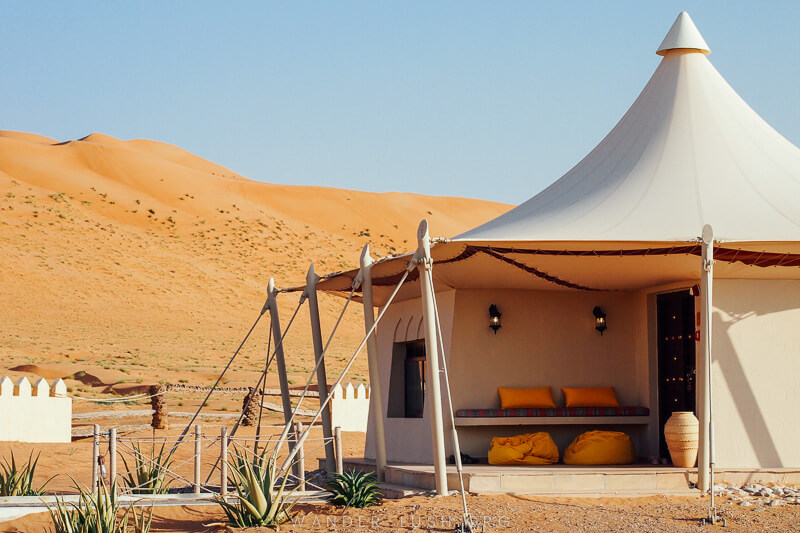
Top Oman experiences
- Touring the Sultan Qaboos Grand Mosque, the largest religious building in Oman
- Taking a sunset cruise in Muscat on a traditional wooden dhow boat
- Snorkelling and dolphin watching in the pristine Daymaniyat Islands on a day trip from Muscat
- Jumping into the iconic Bimmah Sink Hole
- Shopping for Omani souvenirs at Nizwa Souq and Muttrah Souq
- Cooling off at Wadi Shab and Wadi Bani Khalid, Oman’s desert oases
- Exploring the back alleys of a mountain mud village
- Spending a night under the stars at a luxury desert camp
Oman road trip itinerary: Day by day
This day-by-day breakdown of our 10 day Oman road trip covers distances and drive times, activity and accommodation recommendations, and suggested places to stop along the way.
Days 1-2: Muscat

We flew into Muscat’s Seeb International Airport late at night (this was back when AirAsia was trialing a short-lived Bangkok-to-Muscat route), and picked up our pre-booked hire car. Before we left the airport, we bought a local sim card from one of the kiosks in the arrivals lounge.
There’s no guarantee your rental car will come with GPS, so I highly recommend buying a sim card (we used Google Maps throughout our road trip in Oman, and it never let us down). Real-time navigation assistance will make your life a whole lot easier, especially when you’re driving on Muscat’s highways.
The airport in Muscat is small and relatively quiet (especially at night), so we had no trouble getting out of the car park and straight onto the highway. We were living in Phnom Penh at the time, so I hadn’t been behind the wheel in almost a year. Thus there were a few nail-biting moments as we made our way to our accommodation that night.
I can still picture the highway that night – our first look at Oman – infinitely long and lined with palm trees, with the silvery Gulf of Oman just visible to our left window. We made it to our Airbnb unscathed, although we did manage to lose a hubcap!

Where to stay in Muscat
If, like us, you’re arriving in Muscat after dark – or even if you just want to ease into driving in Oman – then I highly recommend spending your first night in Oman in downtown Muscat. Muttrah is a charming suburb and a great place to base your stay, but it’s a full 31km drive from the airport along a rather confusing matrix of overpasses and highways.
By contrast, it’s a straight shot, only around 12km, to the area near Sultan Qaboos Grand Mosque. We chose a great little Airbnb rental hosted by the delightful Ali for our first two nights.
When we came back to Muscat at the end of our trip, we stayed at Mutrah Hotel, which we chose because of its proximity to the city’s biggest marketplace, Muttrah Souk. It’s basic but comfortable, with free parking on-site. Best of all, it’s walking distance to the market and corniche.
If you’re going to Oman to celebrate a special occasion or you just prefer a more luxurious kind of travel, Muscat has some amazing beach side resorts. Located right on the Gulf coast, The Chedi Muscat is a cut above the rest. W Muscat is slightly more economical but no less opulent.
If mid-range is more your style, try Levatio Hotel. And if you’re visiting Oman for a limited amount of time on a layover, I recommend Sundus Rotana near the airport.

Things to do in Muscat
I recommend spending at least two full days in Muscat in order to get a good overview of the city. Having a car in Muscat is priceless: The city is very spread out with minimum public transport options. During the day when it’s hot, the last thing you want to be doing is walking around or trying to hail taxis.
If you haven’t yet picked up your rental car or you prefer to explore Muscat with a guide, there are a couple of Muscat tours that I can recommend. This half-day tour takes in Sultan Qaboos Grand Mosque, several forts, and my favourite museum, Bait Al Zubair. For those with limited time, it follows an ideal Muscat itinerary.
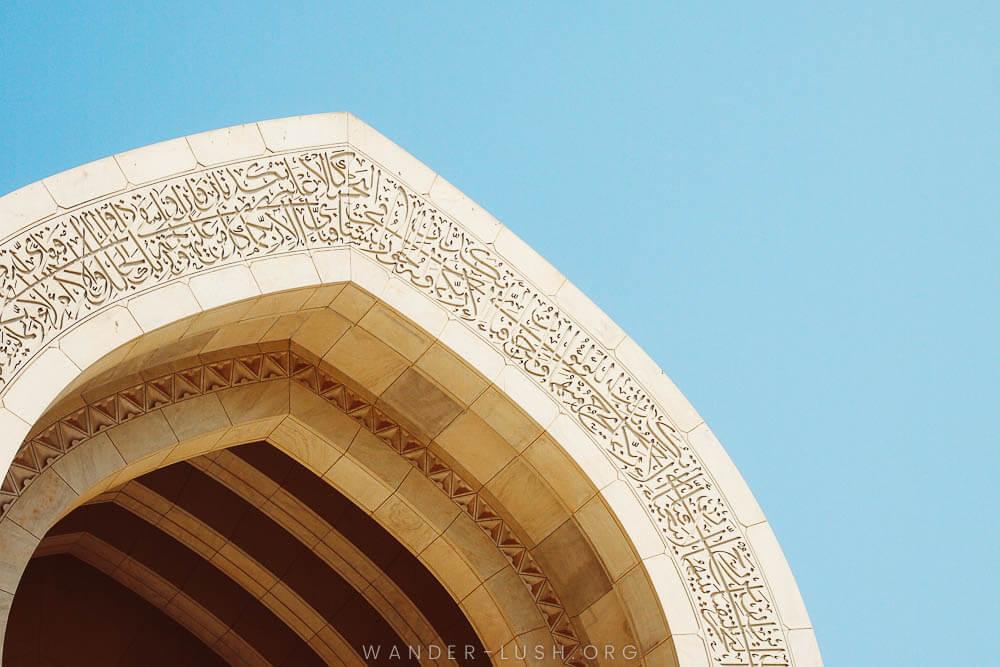

Muscat comes to life once the sun goes down. Head to Muttrah Souq at sunset when the marketplace is bustling with shoppers and stallholders.
End your day in Muscat with either a low-key sunset experience on the beach or a sunset dhow cruise, one of the most atmospheric things you can do in Oman.
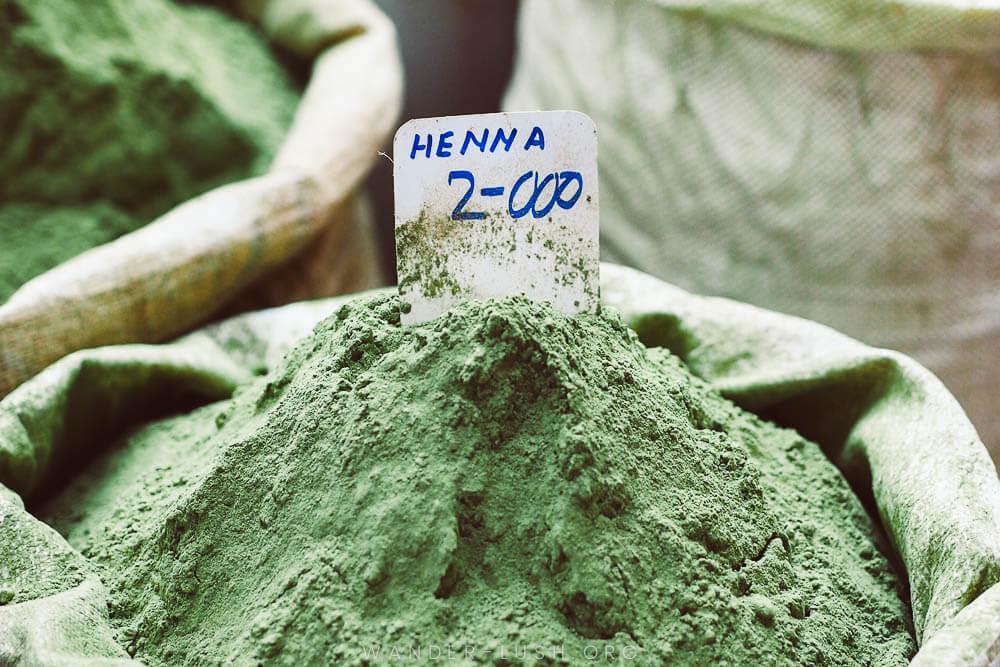

Side trip to the Ad Daymaniyat Islands
Since Oman is so compact and well-connected with highways, you could technically do most of the stops on this road trip itinerary as day trips from Muscat.
Another day trip option close to the city is the Ad Daymaniyat Islands. Ali, our Airbnb host, recommended it as a prime spot for snorkelling and dolphin watching. The Daymaniyats are a set of nine pristine islands, protected by their Nature Reserve status, located roughly 20km off the coast of Barka, which is just up the road from Muscat. A few operators run full and half-day boat trips to the islands from the nearby city of Seeb.
A special permit is required to enter the islands for a day (overnight camping permits are also available). For this reason, it’s best to organise your visit through a tour company that will handle all the logistics for you.
This Ad Daymaniyat snorkelling cruise from Muscat comes recommended by other travellers, and this alternative day tour combines snorkelling and dolphin watching.
Day 3: Muscat to Sur
- Distance covered: 200km
- Total drive time: Approx. 2 hours
- Suggested stops: Bimmah Sink Hole, Wadi Shab
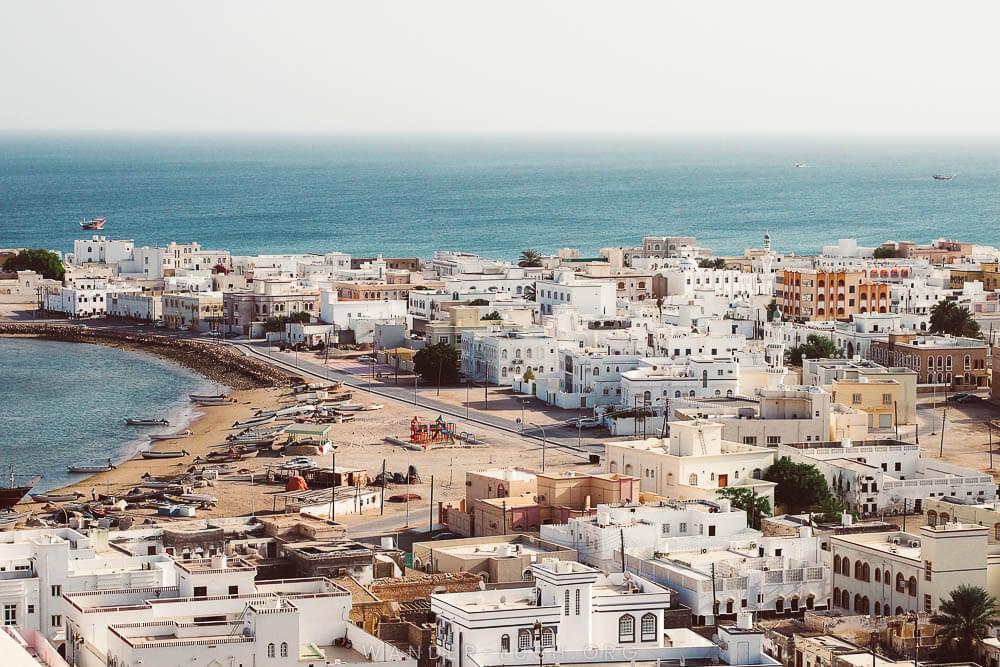
So begins the road trip portion of this itinerary!
We were so psyched for our first full day of driving in Oman, we woke up as the first call to prayer rang out over Muscat. After stocking up on road trip essentials at the nearest supermarket, we hit the road.
The highway connecting Muscat with Sur, a major port city, is smooth and easy to navigate. The two pit stops we made on day three were among the best of our whole trip. In the late afternoon, we pulled into quiet, salt sprayed, white-and-cream-coloured Sur, a wonderful contrast to Muscat.
Bimmah Sinkhole
Our first road stop was the Bimmah Sinkhole (known locally as Hawaiyat Najm). It’s located just off the highway at about the halfway point between Muscat and Sur, 125km (one hour and 20 minutes’ drive) from Muscat.
The sinkhole is enclosed within a park (with picnic areas, toilets and change room facilities), and the front gate doesn’t open until 9am. We were too early, so we waited in the carpark before a guard let us in as the first guests of the day.
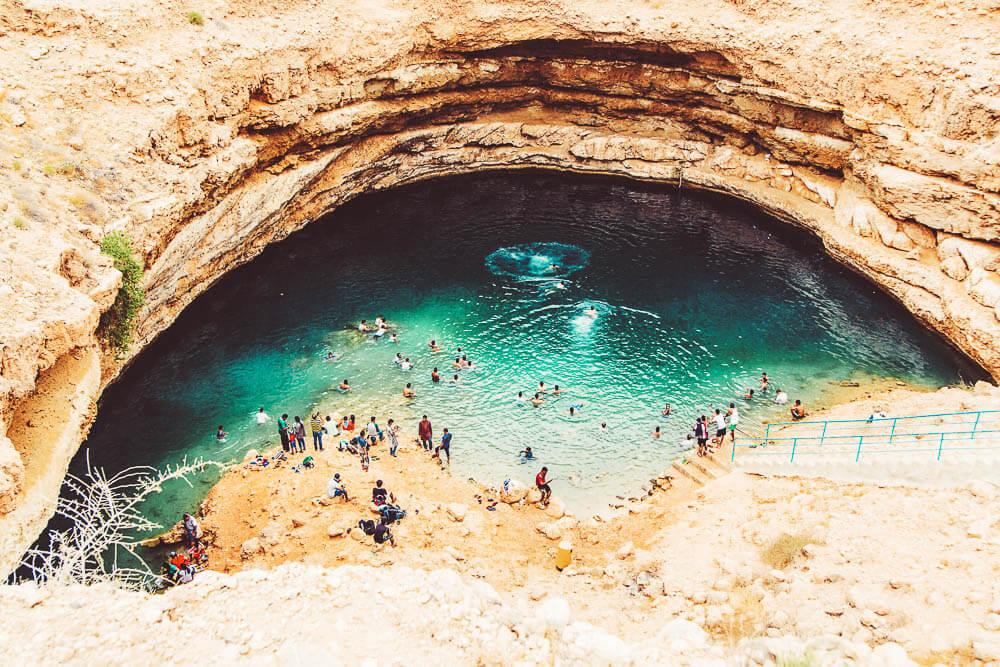
Local legend says that the 20-metre Bimmah Sinkhole was formed by a meteorite. We had the turquoise pool all to ourselves for about 20 minutes before groups of Omani teenagers started arriving to bomb dive off the limestone lip.
Wadi Shab
After Bimmah, we drove for another 30km (about 20 minutes) to Wadi Shab. The entrance to the wadi is located just north of the town of Tiwi: We plugged ‘Wadi Shab parking‘ into Google Maps and it led us to the right spot.
We arrived at an underpass where we parked the car and locked our valuables in the boot. If you don’t feel comfortable doing this, make sure you bring a waterproof bag with you to transport your belongings into the wadi.
From the underpass we boarded a small local boat which took us to the mouth of the wadi. From there, we trekked for 20 or 30 minutes until we reached a spot that looked suitable for swimming.

We followed our noses, squeezing between boulders, until we were inside a large submerged cave. The pool was deep. It was terrifying, but a lot of fun. Once we were satisfied we dried off on our walk back to the boat.
From Wadi Shab, it was another 78km (approximately one hour’s drive) to reach our accommodation in Sur.
Where to stay in Sur
There are a few accommodation options to choose from in Sur. We stayed at the humble but clean Sur Hotel, which is on the peninsular walking distance from the beach and a few decent restaurants. The rooms here are retro and staff are very friendly.
Sur Grand Hotel is a motel-style place with funky carpets. It has a huge outdoor pool, and is located right on the beach north of town.
Day 4: Sur & Ras Al Jinz

We were early to bed on day three, so day four was our first day for exploring Sur. Once the seat of Oman’s colossal maritime power (the Omani Empire extended all the way to Mozambique, Iran and Pakistan in the 19th century), Sur is rumoured to be the spiritual home of Sindbad the Sailor.
It’s a peaceful, very handsome little coastal town.


Things to do in Sur
We had a pretty chilled day in Sur, watching the sun rise over the beach before talking a walk through the city’s quiet neighbourhoods. The architecture and the morning light in Sur are both pretty fantastic, so you should definitely make time to walk the streets, especially if you enjoy taking photos.

We popped down to the waterfront to watch workers making wooden dhow boats. Sur is home to Oman’s only surviving shipyard, and dhow boats are a big deal here.
I also recommend climbing up the Al Ayjah Watchtower for an unreal view of the dhows and Sur’s white houses.
Ras Al Jinz Turtle Reserve
The Ras Al Jinz Turtle Reserve is a must-visit in Oman. Located at the tip of the Arabian Peninsula – about 45 minutes’ drive from Sur – the beaches around Ras Al Jinz are one of the only places on earth where endangered green sea turtles are known to nest 365 nights a year.
For obvious reasons, the area is strictly protected, and you can only access the beach as part of a guided torch-lit tour. Groups depart nightly at 9pm from the Ras Al Jinz Turtle Reserve guest centre and tickets cost 8 OMR (around 21 USD). It’s advisable to book in advance (you can reserve a spot via the website linked above or through your hotel in Sur). Dawn viewings depart the centre at 5am.
We got lucky and saw hoards of hatchlings racing towards the ocean on our evening tour. At the same time, we also witnessed two gigantic turtles nesting on the beach. It was really something.

After the tour, you can either spend the night near the beach (Sama Ras Al Jinz has gorgeous glamping-style cabins) or drive back to your hotel in Sur like we did.
The entire Muscat to Sur coastal road is epic, but it’s particularly dramatic between Sur and Ras. I highly recommend leaving Sur early, while the sun is still shining, so you can get a look at the views.
We ate dinner before our turtle tour in one of the roadside restaurants just before the Turtle Reserve. The drive back to Sur was a touch less pleasurable – there aren’t many (any) streetlights, so take extra care.
For more information about Ras Al Jinz and some great photos of the turtles in action, take a look at this post from Travel Tramp.
Day 5: Sharqiya Sands (Wahbia Sands)
- Distance covered: 174km
- Total drive time: Approx. 2.5 hours
- Suggested stops: Wadi Bani Khalid

Leaving Sur, we headed inland towards the Sharqiya Sands (Wahiba Sands), Oman’s vast desert and the edge of the Arabian ‘Empty Quarter’.
On the way, we stopped at Wadi Bani Khalid, another spectacular oasis in the middle of Oman’s desiccated interior.
Wadi Bani Khalid
There are at least two different points where you can enter this massive wadi, which runs the length of the Jebel Khadar mountain range. We set our sights on the ‘Wadi Bani Khalid Parking Area‘ just off Highway 23, about 130km from Sur.
The walking path up to the wadi is well-signposted. On the day we were there (a Thursday), there were dozens of families and groups making their way in for a dip. There are man-made swimming pools at the start of the wadi, but it’s advisable to continue walking further up until you get to the more isolated ravines.

This wadi is like an all-natural waterpark, complete with boulder sliperty slides, swimming concourses and submerged caves to explore.
We were relaxing under the shade of an overhanging rock when a group of five or six young Omani men appeared. Completely uninhibited, they took of their embroidered skullcaps and threw off their long, white dishdasha robes.
Now in their undergarments (more long white robes), they draped their gear carefully over some nearby rocks before jumping the water. They were eager to chat to us and the few who could speak a little bit of English asked us all kinds of questions. At one point they borrowed my camera to snap photos of each other.

This experience was kind of mind blowing. They were more than happy to strip off in front of us and had no qualms about getting close to me, even touching my arms and shoulders in a totally innocent way. They asked us if we wanted to eat, so we excitedly followed them out of the wadi and trailed their car to the nearest town.
We thought we would be eating together, but no, they just led us to the first decent restaurant and dropped us at the front door. When we had finished eating our maqbous and went to pay the bill, the restaurant owner informed us that the young men had already paid for us! They were incredibly kind.
Desert Nights Camp
After Wadi Bani Khalid and our very moving lunch experience, we drove another 40 minutes to the town of Bidiyah at the edge of the Sharqiya Sands.
We had instructions from our accommodation, the Desert Nights Camp, to park our car at a particular petrol station. From there, a 4WD picked us up and drove us the short distance into the desert.

We settled into our luxury tent before joining a complimentary trip to the top of some sand dunes for sunset.
Running through the sand with wild abandon (and let’s face it, making total fools of ourselves) was an unforgettable experience and another highlight of our time in Oman.

After a magnificent buffet breakfast the next morning, we were driven back to Bidiyah to collect our car.
An unplanned detour…
I had been admiring some woven textiles hanging in the main tent at the desert camp when a staff member suggested we try to visit the local market in nearby Al Mintarib. We drove around for a while, but we couldn’t find any trace of a market (turns out it’s only open on Tuesdays).
Eventually we stopped to ask a group of men for directions. That’s when a middle-aged Omani man decided to jump in the back of our car and take us for an impromptu tour of the town.
We stopped at a fish market, where we saw an old Bedouin woman wearing a batoola. We drove to a house (His cousin’s? Or maybe his uncle’s?) and sat on mattresses on the floor drinking coffee and eating dates with his extended family.
Slightly confused but very touched by the man’s kindness, we eventually had to split and so dropped him back in Al Mintarib before continuing along the highway and into the mountains.
Chance encounters like this are why I always recommend travellers to Oman leave some flexibility in their itinerary. You never know who you might meet or what might happen!
Day 6: Al Hajar mountains & Misfat Al Abriyeen
- Distance covered: 230km
- Total drive time: Approx. 3 hours
- Suggested stops: Ibra, Wadi Ghul, Al Hamra villages
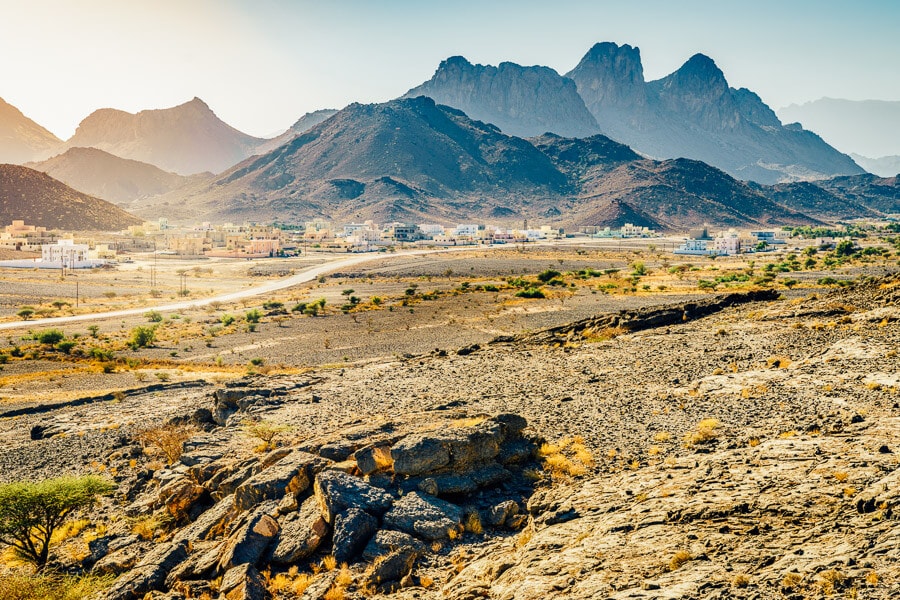
This was our longest day of driving. There are plenty of places to stop off along the way (including Ibra, Nizwa, Bahla and the villages around Al Hamra), but in the end we decided to drive straight to Misfat Al Abriyeen to maximise our time in the village.
We’d seen rocky peaks on the horizon since day one of our Oman road trip, so it was a very cool feeling to finally hit the Hajar mountains and start getting vertical (all on bitumen roads, of course). There are plenty of places to pull over on the way up for photos of Al Hamra’s precarious villages.

Set in the Al Hajar mountains, roughly 1,000m above sea level, Misfat is an ancient, idyllic little community that has been prepped in recent years to receive tourists.
The village’s characteristic mud houses are built atop massive rocks, which gives the village the appearance of blending seamlessly into the mountainside.

Where to stay in Misfat Al Abriyeen
One of the houses has been converted into a guesthouse. Our stay at Misfat Old House was very comfortable, we even got to chat to the owner, who told us a bit about his family and the property’s history.
Rooms are simple, and dinner (cooked up by women in the village) plus a traditional breakfast are served on a glorious open-air terrace.

Things to do in Misfat Al Abriyeen
The best (and only) way to get around Misfat is on foot via a series of marked trails that lead up the mountain and down to the local wadi.
We spent hours wandering along the shaded village paths, photographing the pretty painted gates and poking our heads into crumbling mud houses.

After dinner on the roof of the Old House, we had an early night.
Day 7: Al Hajar to Nizwa
- Distance covered: 82km
- Total drive time: Approx. 1-1.5 hours
- Suggested stops: Al Hoota Cave, Bahla Fort

Nizwa is a mere 55kms from Misfat Al Abriyeen. We knew we were going to have ample time in Nizwa in a few days, and we had missed a few things the previous day, so we decided to squeeze in a few detours.
If you’re driving direct, it only takes about an hour to get to Nizwa from Misfat Al Abriyeen.
Al Hoota Cave
Al Hoota Cave isn’t necessarily a must-see, but we decided to go anyway. We mostly wanted to ride the train that takes visitors from the information centre into the cave, but on the day we went, the train was undergoing maintenance and we had to walk along the tracks instead (ha!). Luckily it wasn’t too hot.
The cave itself is pretty impressive, but nothing to write home about. It’s geared more towards families and young kids. If you do decide to go, you should reserve a spot for one of the designated time slots in advance via the website. Entrance costs 7 OMR for an adult.
Bahla Fort
Known for its distinctive round towers, UNESCO-Listed Bahla Fort it was originally built from mud and straw but underwent a massive renovation before reopening in 2012. We took a long walk through the nearby mud village as well, which was unexpected but really worthwhile.

I have a vivid memory of looking down on a set of flat-roofed mud houses and marvelling at the goats grazing on top. After Bahla, we drove for another 40 minutes to our accommodation in Nizwa.
Days 8 & 9: Nizwa
Nizwa was probably my favourite place in Oman. The ancient city has a laid-back feel, and things just aligned for us in terms of accommodation, food and activities.
Nizwa Fort is the city’s crowning jewel. Dating back to the 12th century, it’s Oman’s most-visited national monument and historically served as the seat of the country’s presiding Imams.
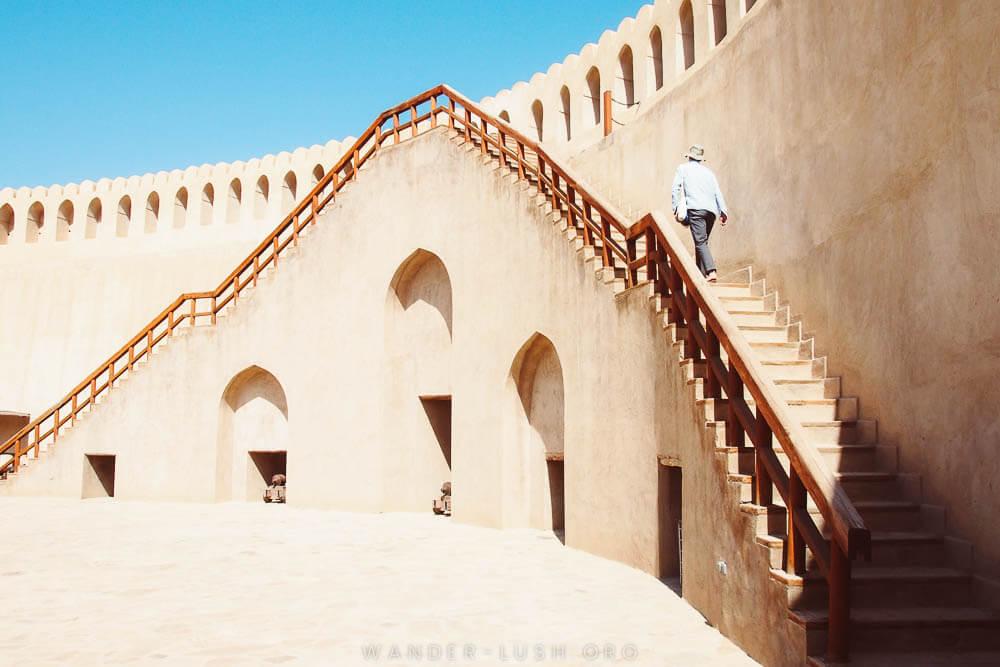
The adjoining Nizwa Souq, famous for its clay pottery, is also top-notch. In my opinion, it even beats out Muttrah Souq in terms of both atmosphere and souvenir offerings.
Where to stay in Nizwa
Date Palm Inn is a great budget-friendly house near the fort, with simple Omani-style rooms and a beautiful courtyard.
For something slightly more up-market, Nizwa Heritage Inn is a splendid little boutique hotel with mud walls, terrace cloisters and Omani rugs sprawled over every floor.
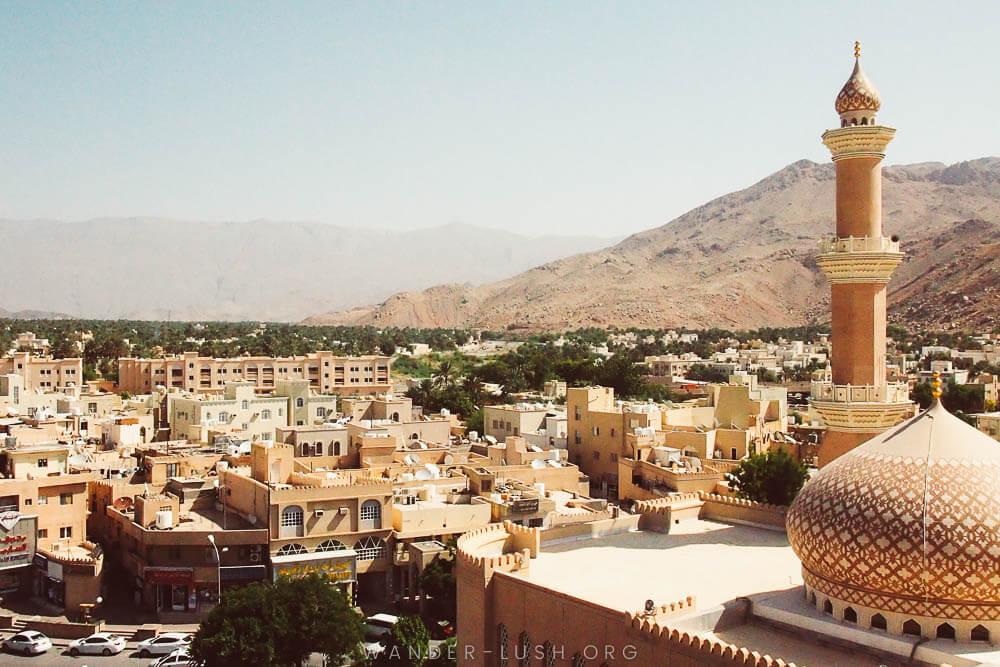
Things to do in Nizwa
When planning your Nizwa itinerary, consider that you can easily spend a whole day at the Fort and the adjoining souq (and honestly, there’s not a whole lot else to do in Nizwa without jumping back in the car).
If you’re lucky enough to be in Nizwa on a Friday morning, make sure you check out the live goat market at the souq.
Read my guide to Nizwa Souq and Oman souvenir shopping.
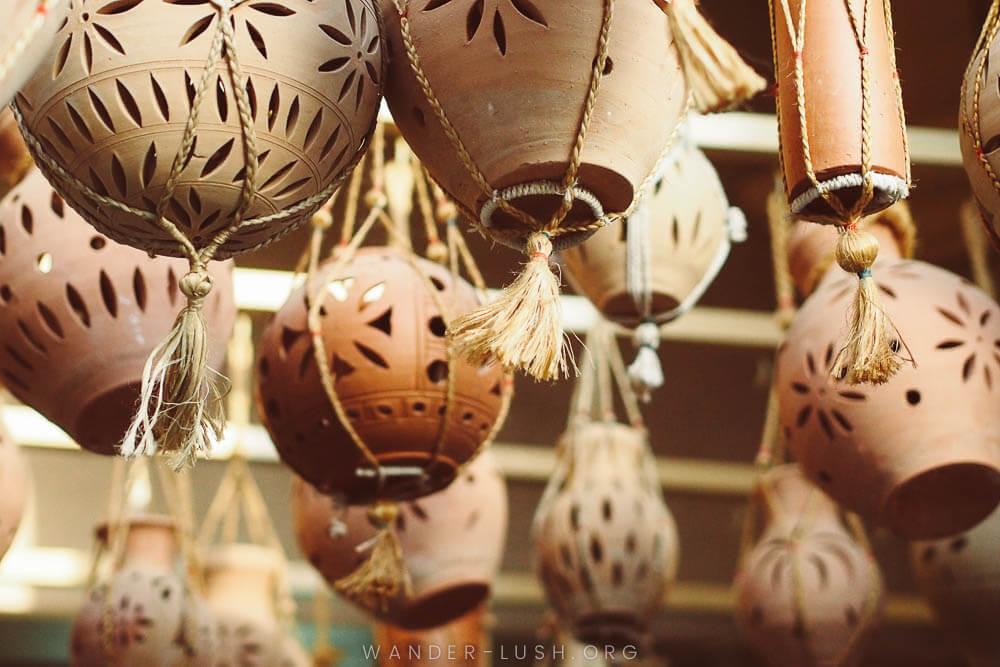
We ate some awesome Turkish and Zanzibari food in Nizwa – and it looks like even more solid restaurant options have popped up since we were there.
Our Airbnb hosts recommended the kebab stands in the carpark opposite Nizwa Souq for an easy dinner. Another winner.
Day 10: Nizwa to Muscat
- Distance covered: 160km
- Total drive time: Approx. 1.5 hours
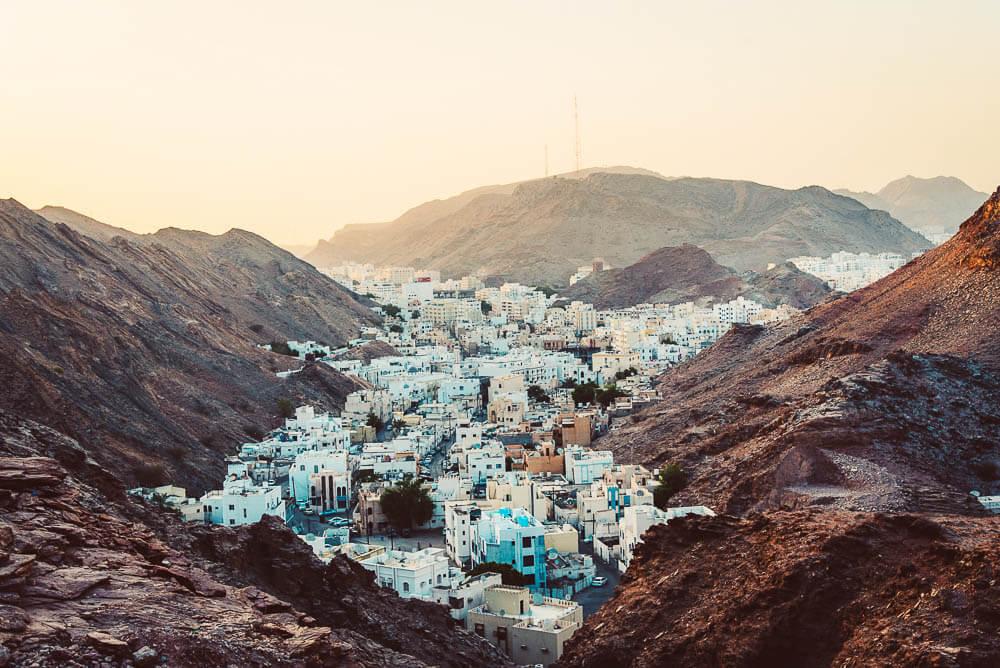
From Nizwa, we headed back to Muscat along Route 15 to get ready for our flight to Bangkok the next evening. As I mentioned earlier, we stayed in Muttrah this time around and spent our final day in Oman exploring the charming alleyways and the souq.
Only in Oman for a short amount of time? Here’s how to make the most of a layover in Muscat.
Alternative road trip routes & add ons
If you have more than 10 days up your sleeve or you’d prefer to visit some of Oman’s less touristy spots, I recommend trying one or more of these alternative routes and add ons.

Ibra
Located on Highway 23, 45 minutes’ drive from Bidiyah on the way to Misfat Al Abriyeen, Ibra is only really worth stopping for on Wednesday mornings. That’s when the weekly women’s market takes place, a strictly female-only bazaar that sees Bedouin women from the Sharqiya Sands converge on Ibra to do their fresh food and textile shopping.
The days didn’t line up for us, but if the timing is right, it’s well worth a look in.
Rustaq Loop
If you have a day to spare in Muscat and you just can’t get enough of driving in Oman, consider adding the Rustaq Loop to your itinerary.
The 250-odd kilometre loop along Highways 13 and 11 runs inland from Barka (60km up the coast from Muscat), past three of Oman’s most spectacular fortresses: Nakhal, Al Rustaq, and Al Hazm. Starting and finishing in Muscat, the loop takes a solid four hours of driving to complete.
Bald Sayt or Wakan
The remote, postcard-perfect villages of Wakan and Bald Sayt are both located relatively close to Misfat Al Abriyeen but are nestled far deeper in the Western Hajar Mountains. There are no paved roads, and it’s only possible to access the valleys if you have a 4WD (either your own vehicle, or by hiring a car and driver for the day from Nizwa or Muscat).
It’s best to approach Wakan and Bald Sayt from a northerly direction. From Highway 13, it’s 30km (just over an hour’s drive) to Bald Sayt, or 31km (30 minutes’ drive) up to Wakan. The exact route and road conditions are unclear, so be sure to do your research before attempting either drive.
Salalah
Most of Oman’s big-ticket attractions are located in the northeast of the country, with the exception of Salalah. Capital of the southern Dhofar province, Salalah sits close to the Oman-Yemen border, roughly 1,000km from Muscat.
Driving to Salalah from Muscat takes a minimum of 10 hours. It’s not really feasible to add it to a 10-day driving route, unless you’re willing to make some big sacrifices to the rest of your itinerary.
There’s an airport in Salalah (and more than nine flights everyday from Muscat), so if you do want to add it, I recommend flying to Salalah for a night or two at the start or the end of your trip.
Musandam Fjords
I’ve heard a few people refer to Khasab as the most beautiful place in Oman. The port city sits in an Omani enclave at the top of the Musandam Peninsula, separated from the rest of the country by the UAE.
To get to Khasab from Muscat overland means driving through the Emirates. Alternatively, Oman Air operates daily flights between the two cities.
Oman to Dubai/Sharjah/Abu Dhabi
If you’re up for a cross-country Middle East road trip adventure, it’s possible to drive from Oman to Sharjah or Dubai (422km, roughly 4.5 hours of driving) or Abu Dhabi (485km, roughly 5 hours of driving). From there, why not continue with the theme and keep on trippin’ around the UAE.
This detailed guide to planning an Oman road trip from Dubai covers everything you need to know about crossing from the UAE to Oman by car.
Oman road trip FAQ: Tips for driving in Oman as a tourist
While we didn’t encounter anything particularly special or unusual about driving in Oman, I can offer some general pointers for a smooth Oman road trip.
Do you need a 4WD for Oman?
When researching for our Oman road trip, I read mixed reports online about the kind of vehicle we would need. We wanted to spend a night in the desert, but we didn’t want to fork out for a 4WD (not to mention the fact that neither of us have ever driven a large vehicle). Part of the reason why we chose Desert Nights Camp was the fact that it provided a free transfer. Other camps, I’m sure, would do the same.
We didn’t need to drive on sand, and we were willing to sacrifice visiting Bald Sayt (even though it was originally on our list), so we ended up hiring a sedan. Our sedan came with instructions not to drive off road, but there were a few occasions when we decided to take shortcuts and ended up driving on unpaved roads. No big deal.
To summarise: Unless you’re planning on going dune bashing or heading majorly off road, you won’t need a 4WD. Even if you want to do those things, it’s not necessarily advisable to brave it alone. Oftentimes a tour is a better options. A sedan will do fine.
Are there any special requirements for foreigners to rent a car in Oman?
Not that I’m aware of. I had to present my passport and Australian driver’s license when I picked up the hire car. I was never asked for an international driver’s permit (good thing, because I didn’t have one) or any other documentation.
We were never pulled over, so I can’t speak to the police requirements. Always double check your requirements with the car rental company before you go.

How much does it cost to drive in Oman?
We originally booked a car through Sixt, but we ended up cancelling. Instead, we found a great deal on an automatic Toyota sedan from Europcar through the Discover Cars website. We paid 185 USD for 10 days, or just 9 USD per person per day.
When we picked up the car in Muscat, we had to make an additional 150 OMR (390 USD) credit card deposit, which Europcar held until we returned the car.
We booked and paid for our rental car well in advance, and I recommend you do the same. Rhino Car Hire is another useful site for finding the best deals.
Read next: 12 money-saving tips for Oman.
Petrol costs peanuts in Oman. The first time we filled up it was quite a novelty—but I stopped noticing after that, since we were only spending pocket change at the pump.
Prices went up in 2018, but fuel in Oman still only costs around 50 US cents per litre (less than one-third of the price of petrol in Australia). Check here for up-to-date prices.
If you follow this itinerary, you’ll mainly be driving on highways, which is of course more fuel efficient. From memory, we only had to fill up the tank three or four times over the course of 10 days.
We didn’t encounter any toll roads on our trip, but apparently there are a few out there, so carry some cash with you at all times.
What are the roads like in Oman?
Oman roads and highways are generally new and well-maintained. In all honesty, driving was a breeze.
Apart from a few hairy moments on the highway in Muscat (the stretch of road down to Muttrah is particularly notorious – there are few exits, so if you miss a turn, you have to loop back), we didn’t have any issues at all. There aren’t any special or obscure road rules (or if there are, I wasn’t aware of them).
In Oman, you drive on the right-hand side of the road.
What’s the car parking situation in Oman?
In a word: Plentiful! If you’re planning to drive in Oman, it’s helpful to know that the country is really spacious, even Muscat. By spacious, I mean you can park your car just about anywhere (curb-side, empty lot, grassy field) and no one will notice or pull you up on it. The only time we had trouble finding a car park was in the densely packed Muttrah area.
Oman is not the sort of place where you have to track down a parking lot or pay for parking. I estimate that at least 99% of people (including tourists) drive in Oman, so most hotels come with parking.
7 essential items to pack for your Oman trip
- A dash-mount phone holder. If you’re driving and using your smart phone to navigate, you’ll need a hands-free dashboard mount. This universal phone holder has a built-in air vent (ideal for driving in warm climates).
- Travel-friendly windshield sun shade. You will thank yourself for packing a sun shade every time you return to your parked car! Rentals don’t tend to include them, so you’ll need to bring your own. This portable soft shield packs down small and is lightweight.
- An waterproof dry bag. Essential for keeping your valuables safe when visiting wadis and sinkholes. This one is perfect for water activities and comes in a range of sizes.
- A scarf for visiting mosques (women). A lightweight cotton scarf is my number one travel item. In Oman, it will come in extra handy for covering your hair when entering a mosque or for draping over your shoulders when visiting a market or a rural area. This neutral travel scarf goes with anything, and it even has a hidden pocket.
- Walking shoes. Comfy walking shoes are absolutely essential for Oman. I love these ones, while my partner lives in these waterproof shoes.
- A reusable water bottle. Avoid single-use plastics whenever you can. I love my S’Well water bottle for warm climates because it doesn’t sweat.
- An Oman guidebook. I recommend the 2019 Lonely Planet guidebook for Oman.
If you’re planning your own Oman road trip and need any advice, feel free to leave a comment below.
Oman road trip: Pin it!


Oman essentials
Here are the websites and services I used when planning my trip to Oman and regularly use for trip planning.
FLIGHTS: Find affordable flights to Muscat on Skyscaner.
VISAS: Oman’s tourist visa requirements and VOA policies have recently changed. Check your visa requirements on the official website and use iVisa to apply for an expedited visa online.
TRAVAL INSURANCE: Insure your trip with HeyMondo, my preferred provider for single-trip and annual travel insurance.
SIM CARD: Purchase an Airalo eSIM for Oman and get instant access to the net when you arrive (prices start from $9).
AIRPORT TRANSFER: Pre-book a private transfer from Muscat Airport to your hotel.
CAR HIRE: Search and compare car rentals using Discover Cars to find the best value for money.
ACCOMMODATION: Find the perfect desert camp, beach resort or Muscat hotel using Booking.com, the most popular booking platform in Oman.
LIMITED TIME? Book a private Muscat city tour to see all the highlights of Oman’s capital.
NO CAR? This 4-day tour of Oman provides a great introduction to Oman.



Hope you will visit Salalah on your next trip.
Absolutely will!
Pretty cool post. I just stumbled upon your article and wished to say that I’ve really enjoyed browsing your blog posts.
Why thank you Cassi! Glad you enjoyed reading my Oman itinerary.
Great tips and write up! I recently did a trip around Oman with a very similar itinerary, but in the reverse direction, and I’d highly recommend it.
I couple of points I’d add to these great recommendations for if you have a 4×4:
1. Driving up to Jebel Akhdar. The drive and the views are spectacular! 4×4 required due to the gradient, and there’s a checkpoint at the bottom to enforce this.
2. The drive along the sand track to Desert Nights in the Wahiba Sands. If you have your own 4×4 doing this is a real experience! I hadn’t driven on sand before (not that this was exactly “dune bashing”!) and it was pretty exhilarating.
Sounds incredible, James! Thanks for sharing your tips!
I really enjoyed reading your article. Do keep up the good work.
Dear Emily, your round-the-world adventure is not only inspirational but also one of its kind adventures I should say. For every reader a traveller like you is a true motivation for those looking into some fun and adventure in life. Thank you for giving us such a vast guide on planning a 10 day road trip in Oman, right from distances between places to right kind of accommodations
You’re more than welcome! Enjoy your trip!
A really beautiful country where you ‘ll find nice landscapes…
Hi Emily
Amazing post. I’m planning a three day trip to Muscat from a Thursday till Sunday morning and was wondering the best bits to capture along with nature and culture too? Any suggestions on what do within a short period of time as I will be hiring out a car as soon as I touch down and will google maps be sufficient with a local sim for directions?
Many thanks
Thanks, Ish! Yep that’s what we did—Google Maps works perfectly.
If I were you, I would head for the sinkhole and wadis on the coast, then head inland to Nizwa. The souq and fortress there are fantastic!
Enjoy your time in Oman!
This post is such a great resource.
This is really informative and helpful to give us an idea of what it will be like when we self-drive in March. It’s going to be outside of our comfort zone – I want an adventure, but one that I can semi-control!
Thanks.
Great to hear, Beverley! Oman is certainly a good compromise between adventure and comfort… It’s very well set up for tourists, and self-driving really makes the experience special.
I hope you enjoy it as much as we did!
Thanks a lot for your elaborate guide Emily!!
Much appreciated and we will be using some of your tips during our road trip in November 2018.
Glad to hear that, Geert! Let me know if there’s anything else I might be able to help with!
Hi, we are going to Oman for 2 weeks in October, and loved your blog. It persuaded us to forget local transport and hire a car! A small request, your route map will not open on Apple devices. Is it possible for you to PDF a screen shot, or similar, of the map, since it would make a handy reference.
Regards, Anne & Peter (Sydney, Australia)
Hi Anne and Peter,
Thanks so much for reaching out! Sorry, that’s my fault—I noticed my embedded maps weren’t working a few weeks ago and have put off trying to fix the issue. I will send it to you directly. Please look out for an email from me soon.
Best,
Emily
Hi Emily, can you e-mail me the map as well, please? I was wondering which route to take between Sharqiyah sands and Misfat al Abriyeen. Thank you.
Hi Nicholas,
The new map is embedded in the post above. As Google Maps shows, the easiest route from Ibra to Misfat follows roads 23, 27, 33, 15, 21 in that order!
Let me know if there’s anything else I can help with.
Emily
Interesting post! Can i rent a car in this country if i am under 25 ? i prefer to book a car in advance but i know that i may have some difficulties with this.
Hi Dylan,
Usually drivers under 25s pay a small surcharge. You should check with the rental company when you make your reservation.
Enjoy!
Never been to the Middle-East and Oman seems like the perfect country to start with. And what a great and comprehensive article! Now I want to do your exact itinerary 😉
I agree! Oman is a great introduction to the Middle East and will definitely leave you wanting more. We were really happy with our itinerary—I hope you get to give it a go soon!
Thanks a lot, Vanda!
Ah, I would love to visit Oman and a road trip around the country sounds lovely!! Pinning this super helpful guide! Thank you!
Thank you, Louise! I hope you get there one day soon 🙂
What an elaborate post! I have a few friend in Oman and when I visit them this guide will come in handy
Brilliant, glad to hear that! Road trips are always more fun with friends…!
Taking a self-drive road-trip is high on our todo list and this one you did in Oman sounds amazing. Oman has never really been on my radar to visit but it sounds fantastic, especially the Turtle Reserve and the Desert Camp. I’m saving this post to help plan our own trip. Thank you.
That’s great to hear! Those were definitely two of the highlights for us.
I hope you get to do your own version of this road trip soon!
Epic journey and blog post. Is a great guide for a road trip. Never thought of seeng Oman like this but know is a beautiful and very safe country. Great idea, saved it for later, as usually people I know went in Oman in an AI resort and kinda explored from there the surroundings, but a road trip offers so much more opportunities!
Thanks, Mirela! Nine times out of 10 I think independent travel is the best way to see a country—and what could be more independent than hitting the road in your own car. You’re right—Oman is very safe and easy to navigate as a tourist. An amazing experience for sure 🙂
OMG, this is the perfect post! Sooo much info and insanely beautiful pictures! I’ve been based in Egypt for the last 1.5 years and love the Middle East, next trip must be to Oman now!
Thanks, Christina! Wow, living in Egypt must be interesting! Lots of travel opportunities right at your doorstep. I definitely recommend checking out Oman!
My sister went there last year, and she loved it so much that she is planning to go back. For sure I will be tagging along. What she told me about the country and what I have just read here makes me want to book my flight right away. Great post!
Wow, she’s lucky! Good idea to tag along! I’m sure you’ll love it.
A road trip through Oman is high on my bucket list as we’ve only done Muscat before
Muscat is just the tip of the iceberg! So much to see and do along the coast and inland—and you’d be surprised how different the country looks and feels once you get out of the city!
Oman’s been on my radar ever since I flew to Kerala last year via Muscat with Oman Air. That may sound like a strange way of being inspired to visit somewhere but the landscapes as we neared Muscat looked absolutely incredible!
This post is definitely being saved and used for research, and your photos are beautiful 🙂
Oh lovely! I hear that Salalah in the south is reminiscent of Kerala, so there’s definitely a connection there. I can imagine that Oman would look incredible from the air! Sadly, we flew in and out at night.
I hope you make it there soon!
So many juicy and wonderful details in here. I’m planning a trip to OMAN likely in the next year, so this will so come in handy. What an inspiring and fun trip!!
So glad to hear that! Let me know if there’s anything I can help with. Happy planning!
Oh my goodness Emily! This is incredible. I can’t wait to visit Oman one day. It’s a destination that looks so photogenic. Sur and Wadi Shah look beautiful 🙂
It’s a photographer’s paradise! The light is really something. I think you’d love it 🙂
Oman has never been on my radar before but reading this and seeing your incredible photos has just got Oman a place on my bucket list! In the airport now about to go on my own road trip around Sicily, I love a driving holiday – so much freedom!
Woohoo! I’ll go (almost) anywhere if it involves a road trip. Oman is perfect for it. Enjoy Sicily! Look forward to reading all about it.
Oman is super high on my list of places I want to get to, and this guide is so incredibly helpful! I’m definitely bookmarking it for when I finally get to the country. I’ve read and heard so many wonderful things about it!
Glad to hear that, Shelley! It’s a really rewarding travel experience. I couldn’t recommend it highly enough! I hope you get there soon! Let me know if you need any more advice 🙂
Thanks for this practical guide, Emily! Road tripping is a marvellous way to explore a new country.
& as always, I love your photography.
Thank you, Mohana! I couldn’t agree more 🙂
Your photos are beyond stunning! Oman looks incredible. Thank you for the great itinerary. As a female that travels solo, would you recommend driving around the country by one’s self?
Thank you, April! Oman is a great place for all types of travellers—I don’t think you’d have any issues travelling solo. The country is very safe, people are friendly, and tourism is very well developed. I was with my partner, but I was the one driving and we certainly didn’t have any problems!
Hi Emily- Thank you for this itinerary, it is super helpful! I have a few questions for you. Do you recommend renting a 4×4/SUV or is sedan ok for a self-drive? Where did you leave your car while at the desert camp? Do you have any recommendations on how I can incorporate 2-3 days in Salalah while sticking to 10 days?
Thanks!
Hi Sarah! Great to hear. Sedan is fine as long as you’re not driving into the desert. The camp we stayed at gave instructions to leave the car at a nearby petrol station and provided a transfer service from there. Most probably do the same, so just check when you book. For Salalah, I would recommend flying down from Muscat as the drive would take a full day or more!
I hope this helps.
I am happy to have found this. We arrive on Jan 1st until the 10th so i think we will follow this almost exactly. We may have to shave off one stop. What that be if you had to omit something? We have booked the first 2 nights in Muscate. we want to sleep at that camp you mentioned in the desert.
Hi David, great to hear! I wouldn’t skip either, but you could definitely shave a night off Sur or potentially Nizwa. Ras Al Jinz was a personal highlight for me, but there’s not a lot else to do in Sur. The desert camp was wonderful – see if you can get a good deal on Agoda – and you should definitely stay in the mud village too. Let me know if there’s anything else I can help you with.
Have a great trip!